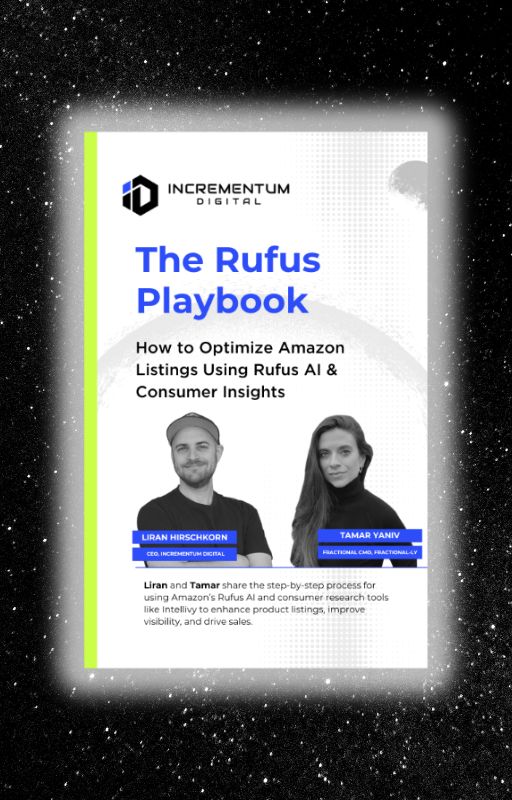Amazon Advertising
Audit Red Flag: Is Your Ad Spend Eating Itself? Watch Out for VCPM Cannibalization!

Recently, our audit team caught another red flag in a brand’s ad strategy—paying for ads just because they show up, even when they aren’t leading to new sales. Worse, those ads were taking credit for purchases customers were going to make anyway! It’s a common issue with VCPM advertising, where you’re charged for every 1,000 impressions, whether or not anyone clicks or engages.

Learn How to Make Listings That Convert in 2025!
Read our step-by-step guide on how to optimize your listings using Rufus AI insights. Sign up for our newsletter and get your copy for free!
Show me howLet’s break down how this happens, why it’s eating into your organic sales, and how you can turn things around to make your ad spend work smarter, not harder. Ready to uncover the truth? Let’s dive in!
What is VCPM Advertising?
VCPM stands for Viewable Cost Per Mille, and it’s a way advertisers pay for their ads based on how many people see the ad, not necessarily how many people click on it.
Here’s how it works: With VCPM, you pay for every 1,000 times your ad is displayed in a place where it’s visible to users for at least a second or two (depending on the ad type). The key thing to remember is that you’re paying for impressions, meaning how often the ad shows up, not how many people actually engage with it. So, even if someone just scrolls by without clicking, it still counts.
How is VCPM different from CPC?
- CPC (Cost-Per-Click) is where you pay only when someone clicks on your ad. The cost is tied directly to the user’s engagement with your ad, making it action-driven.
- VCPM is all about visibility—you’re paying for exposure. It’s more about getting your brand out there in front of people, even if they don’t interact with the ad.
Why Do Brands Choose VCPM?
Some brands use VCPM ads to increase brand awareness. Since you’re paying for impressions, VCPM is often chosen when the goal is to have as many people as possible see the ad. This can be useful when you’re launching a new product or running a big promotion where the goal is to build visibility, even if it doesn’t immediately result in a click or a sale.
For example, if you want your brand or product to appear often on Amazon, VCPM ads can help ensure it shows up in front of a large audience. It’s great for increasing your brand’s presence and potentially staying top-of-mind for future purchases. However, without the direct link to clicks, it’s harder to measure whether those impressions are driving real engagement or sales.
The Red Flag: Cross-Targeting and Organic Sales Cannibalization
One common issue brands face with VCPM ads is that they may unintentionally target their own products in these campaigns. This happens when brands run Sponsored Display ads that show their products to customers who were already likely to purchase them organically—without the ad’s influence. Essentially, the ads are cross-targeting customers who might have bought the product anyway.
The bigger problem with VCPM ads is the lack of transparency in reporting. Since VCPM is based on impressions (how often the ad is displayed), it’s difficult to know whether a customer even saw the ad or simply scrolled past it. Unlike ads where you’re paying per click, there’s no clear data to show how much engagement an ad generates. In VCPM campaigns, the ad is considered “viewable” after being visible for just a second or two, but there’s no guarantee the customer actually noticed it.
This lack of clarity in VCPM reporting can inflate important metrics like conversion rates and ACOS (Advertising Cost of Sale). Since any sale made after the ad is displayed can be attributed to the ad, it creates the illusion that the ad is driving more sales than it really is. Even if the customer was already planning to buy the product, the VCPM ad might take credit for that sale, making the campaign appear far more effective.
As a result, brands might see abnormally low ACOS and high conversion rates, but this can be misleading. In reality, many of those “ad-driven” sales may have been organic, meaning the brand could be cannibalizing its own organic sales—paying for ads that are capturing purchases that would have happened without any advertising. This makes it difficult for brands to truly understand the impact of their ads and can lead to unnecessary ad spend.
Why This Strategy Can Be Problematic
When a brand runs Amazon VCPM campaigns targeting its own products, it risks cannibalizing organic sales. Cannibalization happens when customers who would have purchased the product organically—without seeing an ad—end up being counted as ad-driven sales because the VCPM ad was shown to them, even if they didn’t interact with it. Essentially, the brand is paying for sales it might have gotten for free.
This leads to misleading performance data. Since VCPM ads are based on impressions, and sales are attributed to an ad just because it was displayed, brands often see inflated metrics like low ACOS and high conversion rates. The VCPM campaign may appear to be performing exceptionally well because it’s claiming credit for sales that weren’t truly driven by the ad.
As a result, the brand may believe the VCPM ads are outperforming other ad strategies, but in reality, these ads may just be scooping up sales that would have happened anyway. This distorts performance metrics and can prevent the brand from understanding where its true growth is coming from.
In the long term, this approach can hurt organic sales growth, as the brand might become too reliant on VCPM ads to capture purchases, missing out on opportunities to improve natural rankings or customer loyalty. Brands may end up overspending on ads that aren’t actually bringing in new customers or generating incremental revenue.
Recommended Action: Mitigating the Risk
To avoid the risk of cannibalizing organic sales, brands should first test for cannibalization. This is essential because if VCPM ads are taking credit for organic sales, the brand is paying for ads without gaining new customers or additional revenue. Testing can help determine if the VCPM campaign is genuinely driving incremental sales or just capturing purchases that would have happened anyway.
Here are the steps to test and resolve this issue:
- Pause the VCPM Campaign: Start by temporarily pausing the VCPM ads that are potentially cross-targeting your own products.
- Monitor Organic Sales: After pausing the campaign, track your overall sales for a week or two. Pay close attention to the total number of orders across your Amazon account.
- Evaluate Sales Consistency: If the total sales remain steady after pausing the VCPM campaign, it suggests that the ads were not driving new sales, but rather taking credit for organic purchases. This indicates that the VCPM campaign was cannibalizing your organic traffic.
- Switch to CPC for Cross-Selling: Instead of VCPM, use CPC ads to cross-sell products. CPC gives you clearer attribution, as you only pay for clicks, ensuring you don’t waste spend on ads that don’t drive new sales.
By following these steps, brands can reduce unnecessary ad spend and ensure that their advertising budget is being used to generate incremental sales, not just diverting purchases that would have occurred naturally.
Conclusion
While VCPM ads might seem like an easy win with all those shiny low ACOS and high conversion rates, they can actually be tricking you into thinking you’re getting more value than you really are. Cannibalizing your organic sales and inflating your metrics means you’re not seeing the full picture—and that could lead to wasted ad spend.
The good news? You’re in control. By shifting to CPC ads for cross-selling, you’ll know exactly where your sales are coming from, ensuring you’re boosting your brand in a way that truly moves the needle.
It’s time to audit your Amazon VCPM campaigns, test for cannibalization, and unlock the full potential of your ad strategy.
Not sure where to start? Sign up for our Amazon audit—your brand’s growth deserves nothing less. Let’s make your ads work smarter, not harder.
LET’S DISCOVER WHAT’S POSSIBLE FOR YOUR BRAND
We’re here to listen and uncover opportunities tailored to your unique goals.
Fill out the form to get started, and you’ll walk away with real insights and actionable recommendations—whether we work together or not.
- HANDS-ON LEADERSHIP
- AWARD-WINNING PARTNERSHIPS
- CUSTOM-BUILT SOLUTIONS




